No matter how good the best dirt bike paddle tires are, they won’t get you traction on sand if you don’t have the right pressure. Dirt bikes aren’t like cars, where a pound difference can make a big difference.

What PSI should I use for sand?
Tires that use standard inner tubes should be inflated to 11-12 psi at the front and 10-11 psi at the back for sand. You can get better traction on sand with tires with heavy-duty tubes. However, lowering your tire pressure also means reducing your speed and cornering slower.
For those wondering why front tires need more pressure than rear tires, it’s because they have a smaller cavity, which means less air volume, making them more likely to pinch flat. Dirt bikes with heavy front ends, like four-strokes, make the problem worse.
You shouldn’t confuse dry sand with wet sand. Because dry sand is looser, it can easily trap your bike, requiring a lower tire pressure. Generally, the softer the sand, the lower the tire pressure.
You should also factor in your weight, the weight of your bike, and your speed when determining the best dirt bike tire pressure for sand.
Does lowering tire pressure help in sand?
Yes, lowering tire pressure helps in sand. It helps a lot.
On sand, your dirt bike’s mobility depends on how the sand interacts with your tires. Lowering your tire pressure basically takes some air out of it. By flattening your tires, you increase their contact area with sand.
Because pressure inversely varies with area, a bigger footprint means your weight is distributed over a larger area, which means more friction. It means your tires won’t sink or dig into the sand as much, so you’ll be more mobile.
As well as improving your mobility, lowering your dirt bike tire pressure on sand improves your steering, so you’re more comfortable and safe. Your tires will also last longer because it prevents damage.
What PSI should I run in my dirt bike tires?
You should run 12 psi in your dirt bike tires if you’re an average rider on an average trail. I think it’s a pretty good dirt bike tire pressure that works in most conditions. Dirt bike tire pressure is usually recommended between 8-16 psi, but that’s not optimal.
Optimal tire pressure depends on a lot of factors, two of them being the type of terrain you’re riding on and the type of tires you’re using. This is an overview of the best dirt bike tire pressure for different terrains.
| Tires w/ Standard Tubes | Tires w/ Standard Tubes | Tires w/ Heavy Duty Tubes | Tires w/ Heavy Duty Tubes | |
|---|---|---|---|---|
| Front | Rear | Front | Rear | |
| Sand/ Soft Surfaces | 11-12 psi | 10-11 psi | 9-10 psi | 8-9 psi |
| Track/ Off-road | 12-13 psi | 11-12 psi | 10-11 psi | 9-10 psi |
| Hard/ Rocky/ Sharp Edges | 14-16 psi | 14-15 psi | 13-14 psi | 12-13 psi |
Other than the type of terrain and the quality of your tires, the optimum dirt bike tire pressure in any scenario depends on the following factors:
- Rider weight: Heavier riders need more cushioning and, therefore, more tire pressure.
- Bike weight: Lighter bikes press down less on the tires, so need less tire pressure.
- Tire aspect ratio: The lower your tire profile is, the more pressure you will need.
- Sidewall stiffness: The looser your tire sidewalls are, the more pressure you will need.
- Ride speed: More tire pressure is needed at higher speeds to prevent damage to your tires.
At the end of the day, it’s a traction vs. protection trade-off, which means how much traction will you give up to keep your wheels from getting damaged.
Having a higher tire pressure will prevent pinch flats (because the tires will compress less when they hit hard objects) and protect your rim from damage, which can often be irreversible, but will reduce your traction significantly.
Also read: Best Dirt Bike For Sand Dunes



